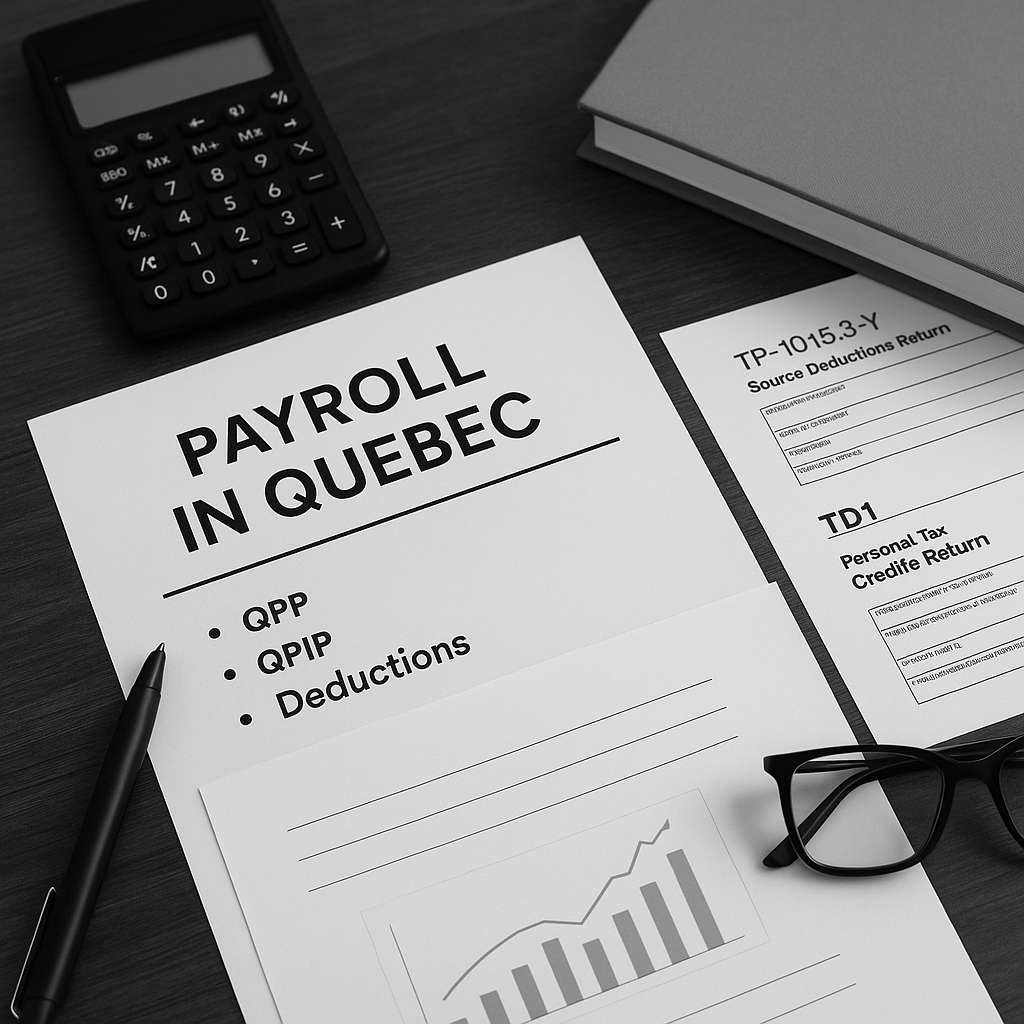Hiring in Quebec comes with unique payroll rules. This quick, practical guide to Payroll in Quebec walks you through the steps to set up payroll correctly, calculate deductions, and remit on time—using 2025 rates where applicable.
Understanding the nuances of Payroll in Quebec is essential for every employer.
Key Considerations for Payroll in Quebec
Implementing effective Payroll in Quebec practices can save businesses time and money.
1) Set up your payroll accounts
Register with Revenu Québec for source deductions (QPP, QPIP, Québec income tax, Health Services Fund) and create a CRA payroll (RP) account to handle Employment Insurance (EI) and federal reporting.
2) Collect employee forms
Have each new hire complete the TP‑1015.3‑V Source Deductions Return (Québec) and the federal TD1 Personal Tax Credits Return to set the right tax credits. Québec updated TP‑1015.3‑V amounts for 2025 (e.g., changes to the career‑extension amount).
Incorporating Payroll in Quebec strategies ensures compliance with local laws.
3) Calculate QPP (Québec Pension Plan) contributions
In 2025, you withhold and match:
- 4% (basic plan) + 1% (first additional) on pensionable earnings above the $3,500 basic exemption up to the MPE $71,300; and
- 4% (second additional) on earnings between $71,300 and $81,200 (YAMPE).
You stop when the employee reaches the year’s maximums. Use Revenu Québec’s tools or tables to avoid over/under‑withholding.
4) Calculate QPIP (Québec Parental Insurance Plan) premiums
For 2025, QPIP rates are unchanged: 0.494% employee and 0.692% employer on insurable earnings up to $98,000. Revenu Québec collects QPIP with your other source deductions.

5) Calculate EI (Employment Insurance) for Quebec
Because QPIP covers parental benefits, Quebec has a reduced EI rate. For 2025 the employee EI rate in Quebec is 1.31% (employer pays 1.4× the employee premium) on insurable earnings up to $65,700. Use the Quebec EI tables and remit EI to the CRA.
Payroll in Quebec can be streamlined with the right software solutions.
6) Add employer‑only Quebec payroll charges
- Health Services Fund (HSF): payable by most employers; 2025 rules include a total‑payroll threshold of $7.8M for reduced rates (primary/manufacturing vs. other sectors). Final rate is reconciled on the RL‑1 Summary.
- Contribution related to labour standards: 06% in 2025 (not applied above the remuneration ceiling, which aligns with $98,000 for 2025).
- WSDRF (“1% training law”): if your annual total payroll exceeds $2M, invest at least 1% in eligible training (or pay the contribution).
- CNESST workers’ compensation: industry‑rated premiums; where applicable, Revenu Québec’s remitting page notes occupational health and safety insurance obligations.
7) Remit to the right authority—on time
Revenu Québec collects Québec income tax, QPP, QPIP and HSF; your remittance frequency (monthly, quarterly, accelerated, annual) depends on thresholds set by Revenu Québec. EI (and other CRA items) are remitted to the CRA. Bookmark the remittance schedules to avoid penalties.
Many companies find that managing Payroll in Quebec requires ongoing education.
8) Year‑end slips and summaries
By the last day of February, issue and file both:
- RL‑1 (to Revenu Québec) plus RL‑1 Summary; and
- T4 and T4 Summary (to the CRA).
Quebec employees typically receive both
Pro tip: keep it audit‑proof
Use Revenu Québec’s Employer’s Kit and calculators; reconcile HSF and other employer contributions at year‑end; and monitor YTD earnings so QPP/QPIP/EI stop at the correct ceilings.
Need help configuring Payroll in Quebec or reviewing a pay run? InfoCplus can set up your accounts, formulas, and calendars so your Quebec payroll is compliant from day one.



